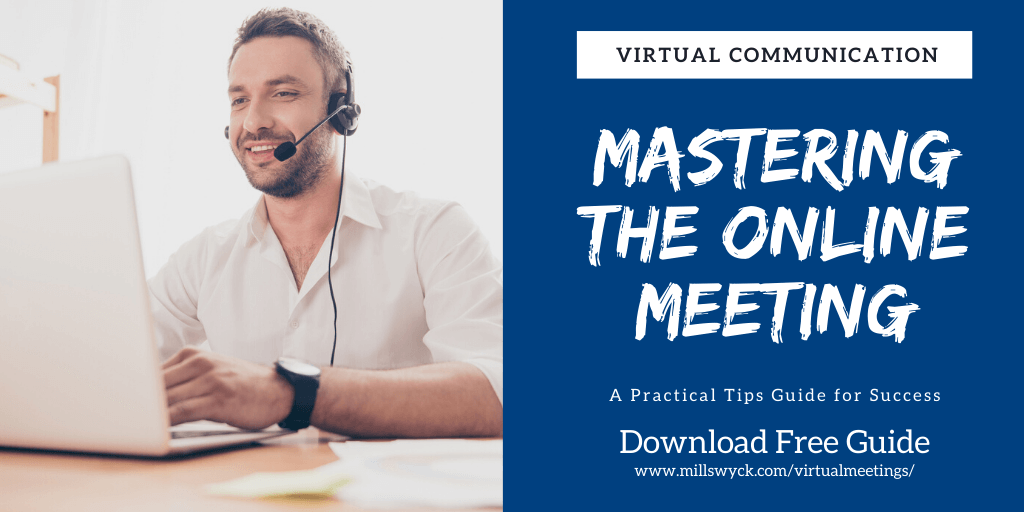Virtual Communication and online meetings are our new reality. (**article written during Covid-19 quarantine**)
Well, that changed quickly, didn’t it?! Since our last monthly connection, the world is a different place. Travel is curtailed, toilet paper (?!) is in short supply, and anything that was once done face-to-face (training, sales, general meetings, interviews) has been moved quickly to the web. With no end in sight, online communication is a part of our new reality.
As I wrote to a client last week, “The world is about to get very good at bad online meetings.” (The world is already good at bad in-person meetings!) When the COVID-19 pandemic hit, I was engaged in the process of coaching several clients remotely (dictated by geography and schedules). It is mere coincidence that the rest of the world started doing it, too. Based on my observations as seemingly everything moves online, I thought it would be worthwhile to address what works and what does not in virtual communication.
Since I was involved in my first web meeting over twenty years ago, I’ve harbored the view that it is probably the most difficult environment to be a great communicator in. The principles of communication don’t change with the environment. But being online adds many difficult parameters and those who are marginal presenters in person may fail miserably on the web. It’s (relatively) easy to pull off a web meeting; it’s (very) difficult to make it matter and come out with the results you want.
Here are three tips for making your new virtual communication world feel more like the real world.
1. Dress for work
I’ve found that I need to treat my workday, well, like a workday. Get out of the PJs and the bunny slippers. Set deadlines. Bathe, shave, and comb the hair. I don’t hear (or at least rarely hear) people apologize for their appearance during in-person meetings. Why should that change in the online environment (for a treatise on how and when to feature something, see this article entitled How to handle blunders and mistakes from the stage). Years ago I went to Disney for a high school graduation event (Grad Night). Disney made us all dress in coats and ties (dresses or pantsuits) because they recognized that we’d act better if we dressed better. It’s true in the work-from-home world as well.
2. Avoid distractions
In the online, virtual communication world, side windows are the norm. Browsers, email readers, and unrelated documents are open. But I wouldn’t sit in a meeting with a client and compose an email to someone outside the room. So why is that OK online? What feels like multitasking is really another way of not giving your attention to the people in the “room”. Virtual communication and meetings are more productive when people are fully engaged. Be fully present where you are.
3. Make the meeting matter
This tip comes from our Powerful Meetings workshop. It’s good advice for any meeting and it applies splendidly to online meetings. Have objectives, not agendas. Agendas appear to mean that people will talk. And talk. And talk. Objectives have an outcome (make a decision or brainstorm ten new revenue ideas, for example). When the outcome is accomplished, the meeting can end. Everyone likes outcomes. Everyone who doesn’t just love to hear themselves talk loves the end of a meeting. If we don’t know what we’ll accomplish, then we won’t know when we’re done. Some really BAD objectives (because they can’t be measured, and probably never end) include:
- Discuss
- Review
- Give an overview
- Talk about
- Introduce
- Present about
- Take questions
- Wrap up
- Offer feedback
- Go through (PowerPoint)
- Explain
- Hammer out
When I was a full-time trainer in corporate America, we were challenged to write course objectives without the words “learn” or “understand”. The same principle is in effect here. Find a more powerful reason to meet than simply talking (most of these bad objectives above could be accomplished better in an email and save everyone the hassle and waste of time of a boring meeting).
WARNING: If a meeting was going to be bad in person, it will be even WORSE online.
4. OK, I’m past my three tips but couldn’t miss an opportunity for this one: END ON TIME!
This is the one immovable rule we teach (in the Western world). There is absolutely no reason for a well-run meeting (or talk) to run over its posted time. End on time (or early) and treat your audience with the respect they deserve. They may even come back for another meeting!
I believe one lasting side effect of this new world we live in is that online meetings will become more of a fixture in our lives. Let’s learn to do them well.
Want more, in-depth tips on Mastering Online Meetings?
Sign up to receive our FULL, in-depth Guide on Virtual Communication: Mastering the Online Meeting where you’ll get practical tips for success.
This Virtual Communication Guide addresses these topics:
- Getting Ready to Meet
- Your Equipment and Setup
- Skills to Make You a Star on the Web
- Content and Facilitation
- Ending Well
Communication matters. What are you saying?
Want more speaking tips? Check out our Free Resources page.
We can also help you with your speech with our Workshops or Personal Coaching.
This article was published in the April Edition of our monthly speaking tips email newsletter, Communication Matters. Have speaking tips like these delivered straight to your inbox every month. Sign up today to receive our newsletter and receive our FREE eBook, “Twelve Tips that will Save You from Making a Bad Presentation.” You can unsubscribe at any time.






